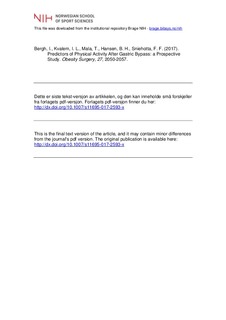| dc.contributor.author | Bergh, Irmelin | |
| dc.contributor.author | Kvalem, Ingela Lundin | |
| dc.contributor.author | Mala, Tom | |
| dc.contributor.author | Hansen, Bjørge Herman | |
| dc.contributor.author | Sniehotta, Falko F. | |
| dc.date.accessioned | 2018-08-29T11:46:29Z | |
| dc.date.available | 2018-08-29T11:46:29Z | |
| dc.date.created | 2017-02-17T13:08:47Z | |
| dc.date.issued | 2017 | |
| dc.identifier.citation | Obesity Surgery. 2017, 27, 2050-2057 | |
| dc.identifier.issn | 0960-8923 | |
| dc.identifier.uri | http://hdl.handle.net/11250/2559863 | |
| dc.description | I Brage finner du siste tekst-versjon av artikkelen, og den kan inneholde ubetydelige forskjeller fra forlagets pdf-versjon. Forlagets pdf-versjon finner du på springerlink.com / In Brage you'll find the final text version of the article, and it may contain insignificant differences from the journal's pdf version. The definitive version is available at springerlink.com | |
| dc.description.abstract | Background: Most patients do not meet the recommended level of physical activity after bariatric surgery, and psychological factors underlying postoperative physical activity remain poorly understood. This study aimed at identifying self-regulatory predictors of physical activity after bariatric surgery.
Methods: Questionnaire data including self-regulation variables and the short-version of the International Physical Activity Questionnaire were obtained in a prospective cohort of 230 patients 1 year after Roux-en-Y gastric bypass. The study sample consisted of participants consenting to wear an ActiGraph GT3X+ accelerometer for seven consecutive days, 18–24 months after surgery (n = 120).
Results: A total of 112 participants with complete self-report data provided valid accelerometer data. Mean age was 46.8 years (SD = 9.3), and 81.3% was women. Preoperative and postoperative BMI was 44.8 ± 5.5 and 30.6 ± 5.0 kg/m2, respectively. Total weight loss was 28.9% (SD = 7.5). By objective measures, 17.9% of the participants met the recommended level of moderate-to-vigorous-intensity of physical activity of ≥150 min/week, whereas 80.2% met the recommended level according to self-reported measures. Being single, higher education level, and greater self-regulation predicted objective physical activity in multivariate regression analysis. Greater self-regulation also predicted self-reported physical activity. Weight loss 1 year after surgery was not associated with self-reported or objectively measured physical activity.
Conclusions: Despite large differences between accelerometer-based and subjective estimates of physical activity, the associations of self-regulatory factors and weight loss with postoperative physical activity did not vary depending on mode of measurement. Self-regulation predicted both objective and self-reported physical activity. Targeting patients’ self-regulatory ability may enhance physical activity after gastric bypass. | |
| dc.language.iso | eng | |
| dc.subject | physical activity | |
| dc.subject | bariatric surgery | |
| dc.subject | gastric bypass | |
| dc.subject | self-regulation | |
| dc.subject | accelerometer | |
| dc.subject | behavior change | |
| dc.title | Predictors of physical activity after gastric bypass : a prospective study | |
| dc.type | Peer reviewed | |
| dc.type | Journal article | |
| dc.description.version | acceptedVersion | |
| dc.source.pagenumber | 2050-2057 | |
| dc.source.volume | 27 | |
| dc.source.journal | Obesity Surgery | |
| dc.source.issue | 8 | |
| dc.identifier.doi | 10.1007/s11695-017-2593-x | |
| dc.identifier.cristin | 1451676 | |
| dc.description.localcode | Seksjon for idrettsmedisinske fag / Department of Sports Medicine | |
| cristin.unitcode | 150,34,0,0 | |
| cristin.unitname | Seksjon for idrettsmedisinske fag | |
| cristin.ispublished | true | |
| cristin.fulltext | postprint | |
| cristin.qualitycode | 1 | |
